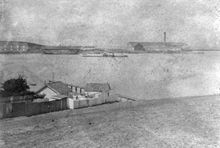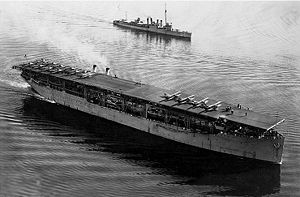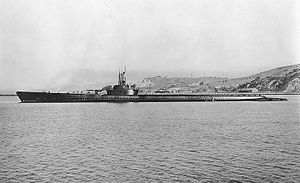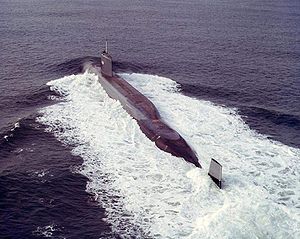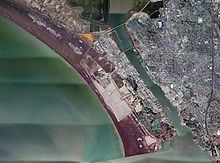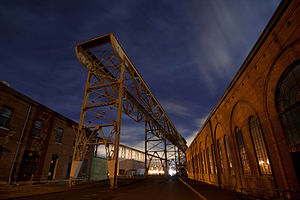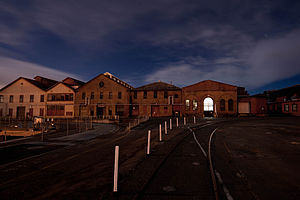- Mare Island Naval Shipyard
-
Mare Island Naval Shipyard

Location: Vallejo, California Coordinates: 38°5′24″N 122°15′48″W / 38.09°N 122.26333°WCoordinates: 38°5′24″N 122°15′48″W / 38.09°N 122.26333°W Built: 1854 Governing body: private NRHP Reference#: 75002103[1] Significant dates Added to NRHP: May 15, 1975 Designated NHLD: May 15, 1975[2] The Mare Island Naval Shipyard (MINSY) was the first United States Navy base established on the Pacific Ocean.[3] It is located 25 miles northeast of San Francisco in Vallejo, California. The Napa River goes through the Mare Island Strait and separates the peninsula shipyard (Mare Island, California) from the main portion of the city of Vallejo. MINSY made a name for itself as the premier US West Coast submarine port as well as serving as the controlling force in San Francisco Bay Area shipbuilding efforts during World War II.[4] The base closed in 1996 and has gone through several redevelopment phases. Parts of it including 52 buildings[5] were declared a National Historic Landmark District in 1975.[2]
Contents
Beginnings
The Navy purchased the original 956 acres (3.9 km²) of MINSY in 1853 and commenced shipbuilding operations on September 16, 1854 under the command of then-Commander David Farragut, who would later gain fame during the US Civil War Battle of Mobile Bay, when he gave the order, "Damn the torpedoes, full speed ahead!" MINSY served as a major Pacific Ocean repair station during the late 19th century, handling American as well as Japanese and Russian vessels in the course of duty.
In 1861, the longest lived of the clipper ships, Syren, was brought to Mare Island Navy Yard for $15,000 of repairs. Syren had struck Mile Rock two times while beating out of the Golden Gate.[6]
By 1901, this shipyard, Union Iron Works, was contracted out by John Philip Holland's (Holland Torpedo Boat Company) to build two Adder-class (later A-class) submarines. They were known as USS Grampus / A-3 and USS Pike / A-5 and were the first United States Navy submarines built on the West Coast.
Mare Island Naval Shipyard also took a commanding role in civil defense and emergency response on the West Coast, dispatching warships to the Pacific Northwest to subdue Native American uprisings. MINSY sent ships such as Wyoming south to Central America and the Panama Canal to protect US political and commercial interests. Some of the support, logistics and munition requirements for the Spanish-American War were filled by Mare Island. MINSY sent men, materiel and ships to San Francisco in response to the fires following the 1906 earthquake. Arctic rescue missions were mounted as necessary. Ordnance manufacturing and storage were two further key missions at MINSY for nearly all of its active service, including ordnance used prior to the American Civil War.[7]
World War I
In March 1917 MINSY was the site of a major explosion of barges loaded with munitions. The blast killed 6 people, wounded another 31, and destroyed some port facilities. Agents of U.S. Military Intelligence tied the blast to roving German saboteur Lothar Witzke,[8] who was caught and imprisoned in 1918.
MINSY saw major shipbuilding efforts during World War I. MINSY holds a shipbuilding speed record for a destroyer that still stands, launching the USS Ward in just 17½ days in May–June 1918.[9] Mare Island was selected by the Navy for construction of the only US West Coast-built battleship, the USS California, launched in 1919. Noting the power of underwater warfare shown by German U-boats in WWI, the Navy doubled their Pacific-based submarine construction program at Puget Sound Naval Shipyard by founding a submarine program at MINSY in the early 1920s.[10]
On January 1, 1918, the Marine Detachment of Mare Island won the Rose Bowl, defeating the US Army team fielded by Camp Lewis by a score of 19-7. One year later they appeared in the Rose Bowl again, this time losing by a 17-0 score to a Great Lakes Naval Station team that included future football legends George Halas, Paddy Driscoll and Jimmy Conzelman.
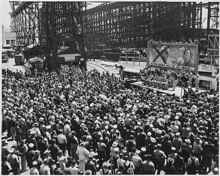 The AJC Band, from Hamilton Field, plays at a war bond rally held at Mare Island on June 26, 1945. Behind the band, caricatures of Mussolini and Hitler have been crossed out and a fanged Japanese figure is labeled "Tough One To Go"
The AJC Band, from Hamilton Field, plays at a war bond rally held at Mare Island on June 26, 1945. Behind the band, caricatures of Mussolini and Hitler have been crossed out and a fanged Japanese figure is labeled "Tough One To Go"
World War II
During World War II, MINSY reached peak capacity for shipbuilding, repair, overhaul, and maintenance of many different kinds of seagoing vessels including both surface combatants and submarines. Up to 50,000 workers were employed.[11] Mare Island even received Royal Navy cruisers and destroyers and four Soviet Navy subs for service.[4] Following the War, MINSY was considered to be one of the primary stations for construction and maintenance of the Navy's Pacific fleet of submarines, having built seventeen submarines and four submarine tenders by the end of hostilities.
War bonds
Patriotism and esprit de corps among the workers ran very high. Mare Island's military and civilian workforce raised almost $76M in war bonds; enough to pay for every one of the submarines built at MINSY prior to VJ Day. More than 300 landing craft were built at Mare Island.[12][13]
Shipbuilding
Mare Island Naval Shipyard constructed at least eighty-nine sea-going vessels. Among the more important ships & boats built were:
- 1858 USS Saginaw – sloop-of-war, wood
- 1872 USS Mohican – sloop-of-war, wood
- 1875 USS Monadnock – monitor, steel
- 1886 cutter, wood
- 1904 USS Intrepid – training ship, steel
- 1907 USS Prometheus – collier, steel
- 1911 USS Jupiter – collier, steel. Later converted to aircraft carrier USS Langley
- 1913 USS Kanawha – tanker, steel
- 1913 gunboat, steel
- 1913 USS Monocacy – gunboat, steel
- 1914 USS Maumee – tanker, steel
- 1915 USS Cuyama – tanker, steel
- 1916 USS Shaw, destroyer - steel
- 1916 USS California – battleship, steel (32,500 ton)
- 1916 USS Caldwell – destroyer, steel
- 1917 Fifteen submarine chasers - wood
- 1917 Fairfax – destroyer (Destroyers for Bases Agreement)[15]
- 1917 Taylor – destroyer
- 1918 Boggs – destroyer (World War II)
- 1918 Kilty – destroyer (Guadalcanal campaign - Philippines campaign (1944-45) - Battle of Okinawa)
- 1919 Kennison – destroyer (World War II)
- 1918 Ward - destroyer (Attack on Pearl Harbor – Guadalcanal campaign - Philippines campaign (1944-45))
- 1918 Claxton – destroyer (Destroyers for Bases Agreement)[15]
- 1919 Hamilton – destroyer (invasion of North Africa - Philippines campaign (1944-45))
- 1920 Montana – battleship (43,200-ton) (scrapped under terms of the Washington Naval Treaty)
- 1920 Litchfield – destroyer (World War II)
- 1920 Zane – destroyer (Attack on Pearl Harbor – Guadalcanal campaign)
- 1921 Wasmuth – destroyer (Attack on Pearl Harbor)
- 1922 Trever – destroyer (Attack on Pearl Harbor – Guadalcanal campaign)
- 1922 Perry – destroyer (Attack on Pearl Harbor - Battle of Peleliu)
- 1922 Decatur – destroyer (World War II)
- 1927 USS Nautilus – submarine (sank 6 ships in 14 World War II Pacific patrols)[16]
- 1928 USS Chicago – cruiser (Battle of Savo Island - Battle of Rennell Island)
- 1931 USS San Francisco – cruiser (Attack on Pearl Harbor - Battle of Cape Esperance - Naval Battle of Guadalcanal - Battle of the Philippine Sea[17] - Philippines campaign (1944-45) - Battle of Okinawa)
- 1934 USS Smith – destroyer (Battle of the Santa Cruz Islands - Philippines campaign (1944-45))
- 1934 USS Preston – destroyer (Battle of the Santa Cruz Islands - Naval Battle of Guadalcanal)
- 1935 USS Henley – destroyer (Attack on Pearl Harbor - Guadalcanal campaign)
With the prelude to, and the outbreak of World War II, the Mare Island Naval Shipyard specialized in submarines, and other than a few submarine tenders, no more surface ships were built there. MINSY continued building non-nuclear subs through the Cold War including two of the three Barracuda-class submarines and the Grayback, an early guided missile launcher. In 1955, Mare Island was awarded the contract to build Sargo, the first nuclear submarine laid down at a Pacific base. The shipyard became one of the few that built and overhauled nuclear submarines, including several UGM-27 Polaris submarines. 1970 saw the launching of USS Drum, the last nuclear submarine built in California. In 1972, the Navy officially ceased building new nuclear submarines at Mare Island, though overhaul of existing vessels continued. The Nautilus was decommissioned at Mare Island in 1980, then rigged for towing back to Groton, Connecticut to serve as a museum of naval history.[18]
- 1936 USS Pompano – submarine (sank 6 ships in 7 World War II Pacific patrols[19])
- 1936 USS Sturgeon – submarine (sank 9 ships in 11 World War II Pacific patrols[20])
- 1937 USS Swordfish – submarine (sank 12 ships in 13 World War II Pacific patrols[21])
- 1939 USS Fulton – submarine tender (World War II)
- 1939 USS Tuna – submarine (sank 4 ships in 13 World War II Pacific patrols[22])
- 1939 USS Gudgeon – submarine (sank 11 ships in 12 World War II Pacific patrols[23])
- 1941 USS Sperry - submarine tender[24] (World War II)
- 1941 USS Silversides - submarine[25] (sank 23 ships in 14 World War II Pacific patrols (3rd highest number for a U.S. submarine)[26])
- 1941 USS Trigger - submarine[25] (sank 18 ships in 12 World War II Pacific patrols (11th highest number for a U.S. submarine)[27])
- 1942 USS Bushnell - submarine tender[24] (World War II)
- 1942 USS Wahoo - submarine[28] (sank 20 ships in 7 World War II Pacific patrols (6th highest number for a U.S. submarine)[29])
- 1942 USS Whale - submarine[28] (sank 9 ships in 11 World War II Pacific patrols[30])
- 1942 USS Sunfish - submarine[28] (sank 15 ships in 11 World War II Pacific patrols[16])
- 1942 USS Tunny - submarine[28] (sank 7 ships in 9 World War II Pacific patrols[31] Vietnam War)
- 1942 USS Tinosa - submarine[28] (sank 16 ships in 11 World War II Pacific patrols[31])
- 1942 USS Tullibee - submarine[28] (sank 3 ships 4 World War II Pacific patrols[32])
- 1943 USS Howard W. Gilmore - submarine tender[24] (World War II)
- 1943 USS Seahorse - submarine[33] (sank 20 ships in 8 World War II Pacific patrols (6th highest number for a U.S. submarine)[34])
- 1943 USS Skate - submarine[33] (sank 10 ships in 7 World War II Pacific patrols[31])
- 1943 USS Tang - submarine[33] (sank 24 ships in 5 World War II Pacific patrols (2nd highest number for a U.S. submarine)[35])
- 1943 USS Tilefish - submarine[33] (sank 2 ships 6 World War II Pacific patrols[36])
- 1944 USS Spadefish - submarine[37] (sank 21 ships in 5 World War II Pacific patrols (4th highest number for a U.S. submarine)[26])
- 1944 USS Trepang - submarine[37] (sank 11 ships in 5 World War II Pacific patrols[30])
- 1944 USS Spot - submarine[37] (sank 1 ship in 3 World War II Pacific patrols[30])
- 1944 USS Springer - submarine[37] (sank 4 ships in 3 World War II Pacific patrols[30])
- 1945 USS Nereus - submarine tender[24]
- 1945 USS Stickleback - submarine[37] (1 World War II Pacific patrol[36])
- 1947 USS Tiru - submarine[37]
- 1951 USS Bass - submarine
- 1951 USS Bonita - submarine
- 1957 USS Grayback - submarine[38]
- 1957 USS Sargo - submarine[39]
- 1959 USS Halibut - submarine[40]
- 1959 USS Theodore Roosevelt - submarine[41]
- 1960 USS Scamp - submarine[42]
- 1961 USS Permit - submarine[43]
- 1961 USS Plunger - submarine[43]
- 1962 USS Andrew Jackson - submarine[44]
- 1963 USS Woodrow Wilson - submarine[44]
- 1963 USS Daniel Boone - submarine[44]
- 1963 USS Stonewall Jackson - submarine[44]
- 1964 Bathyscaphe Trieste II - deep submergence bathyscaphe
- 1965 USS Kamehameha - submarine[44]
- 1965 USS Mariano G. Vallejo - submarine[44]
- 1967 USS Gurnard - submarine[45]
- 1968 USS Guitarro - submarine[45]
- 1969 USS Hawkbill - submarine[45]
- 1969 USS Pintado - submarine[45]
- 1970 USS Drum - submarine[45]
Riverine training
In 1969, during the Vietnam War, the US Navy transferred their Brown Water Navy Riverine Training Operations from Coronado, California to Mare Island. Motorists traveling along Highway 37 from the Vallejo/Fairfield areas to the Bay Area, which passes through Mare Island, could often view US Navy Swift Boats (PCF-Patrol Craft Fast) and PBRs (Patrol Boat River), among other riverine type boats, maneuvering through the sloughs of what is now the Napa-Sonoma State Wildlife Area, which borders the north and west portions of Mare Island. US Navy Reserve Units may still operate the slough portions of the State Wildlife Area for training purposes, as the navigable waters are considered public property. The US Navy Brown Water Riverine Forces inactivated after the Vietnam War, maintaining only the US Naval Reserve PBRs and auxiliary craft at Mare Island, until the 1996 base closure; at which time the Reserve units moved to new facilities in Sacramento, California.[citation needed]
Base closure
Mare Island Naval Shipyard expanded to over 5,200 acres (21 km²) in its service life and was responsible for construction of over 500 naval vessels and overhauling thousands of other vessels. Though it remained a strong contender for continued operations, MINSY was identified for closure during the Base Realignment and Closure (BRAC) process of 1993. Naval operations ceased and the facility was decommissioned on April 1, 1996.
The California Conservation Corps, Touro University, and numerous commercial and industrial businesses are currently leasing property aboard the former naval shipyard. In May 2000, the Navy completed the transfer of a former housing area called Roosevelt Terrace using an "economic development conveyance"; a method to accelerate the transfer of BRAC facilities back to civilian communities for their economic benefit. The Navy is also transferring property at the shipyard to other government agencies such as Fish and Wildlife Service refuge, a Forest Service office building, an Army Reserve Center, a Coast Guard communications facility, and a Department of Education school.
See also
References
- Notes
- ^ "National Register Information System". National Register of Historic Places. National Park Service. 2008-04-15. http://nrhp.focus.nps.gov/natreg/docs/All_Data.html.
- ^ a b NHL Summary
- ^ NHL Writeup[dead link]
- ^ a b Battleship Iowa: Mare Island
- ^ NPS Redbook[dead link]
- ^ Howe, Octavius T; Matthews, Frederick C. (1927). American Clipper Ships 1833-1858. Volume 2, Malay-Young Mechanic. Salem, MA: Marine Research Society. pp. 653–656.
- ^ Lott, A Long Line of Ships, pp. 3-134.
- ^ World War One By Priscilla Mary Roberts, page 1606
- ^ Mare Island History. Vallejo Convention & Visitors Bureau website. Accessed August 22, 2007
- ^ Lott, A Long Line of Ships, pp. 161-180.
- ^ Kern, James & Vallejo and Naval Historical Museum Images of America: Vallejo. Arcadia Publishing, 2004.
- ^ FAS Military Analysis Network: Mare Island Naval Shipyard (MINSY)
- ^ Lott, A Long Line of Ships, pp. 209-237.
- ^ Craft & Coast Guard-Manned Army & Navy Vessels
- ^ a b Fahey, The Ships and Aircraft of the U.S. Fleet, p.17
- ^ a b Blair, Silent Victory vol 2, p.945
- ^ Tillman(2005)pp.301-306
- ^ Chief of Naval Operations, Submarine Warfare Division: Submarine Chronology
- ^ Blair, Silent Victory vol 2, p.907
- ^ Blair, Silent Victory vol 2, p.926
- ^ Blair, Silent Victory vol 2, p.939
- ^ Blair, Silent Victory vol 2, p.946
- ^ Blair, Silent Victory vol 2, p.919
- ^ a b c d Silverstone, U.S. Warships of World War II, p.287
- ^ a b Silverstone, U.S. Warships of World War II, p.195
- ^ a b Blair, Silent Victory vol 2, pp.953&965
- ^ Blair, Silent Victory vol 2, pp.945&965
- ^ a b c d e f Silverstone, U.S. Warships of World War II, p.197
- ^ Blair, Silent Victory vol 2, pp.913&965
- ^ a b c d Blair, Silent Victory vol 2, p.954
- ^ a b c Blair, Silent Victory vol 2, p.953
- ^ Blair, Silent Victory vol 2, p.918
- ^ a b c d Silverstone, U.S. Warships of World War II, p.199
- ^ Blair, Silent Victory vol 2, p.956
- ^ Blair, Silent Victory vol 2, pp.933&965
- ^ a b Blair, Silent Victory vol 2, p.957
- ^ a b c d e f Silverstone, U.S. Warships of World War II, p.203
- ^ Blackman Jane's 1970-71, p.473
- ^ Blackman Jane's 1970-71, p.472
- ^ Blackman Jane's 1970-71, p.470
- ^ Blackman Jane's 1970-71, p.406
- ^ Blackman Jane's 1970-71, p.469
- ^ a b Blackman Jane's 1970-71, p.468
- ^ a b c d e f Blackman Jane's 1970-71, p.403
- ^ a b c d e Blackman Jane's 1970-71, p.466
- Bibliography
- Blackman, Raymond V.B. Jane's Fighting Ships 1970-71. London: Jane's Yearbooks.
- Lott, Arnold S., Lt. Comdr., U.S.N. A Long Line of Ships: Mare Island's Century of Naval Activity in California. Annapolis: United States Naval Institute, 1954.
- Silverstone, Paul H., U.S. Warships of World War II. New York: Doubleday & Company, 1968.
- Steffes, James, ENC Retired. Swift Boat Down- The Real Story of the Sinking of PCF-19. (2006); ISBN 1-59926-612-1
- Tillman, Barrett Clash of the Carriers. New York: New American Library, 2005. ISBN 978-0-451-21965-5
- 1941 Society of Naval Architects Bulletin, Harold W. Linnehan, writing as a visitor from Design section, Mare Island, California.
External links
- Brief history written in 1939
- Recently written history with photos
- Mare Island Navy Yard - 1928. Elbridge Ayer Burbank pencil sketch.
- National Park Service World War II in the San Francisco Bay Area: Mare Island Naval Shipyard
- Mare Island Historic Park Foundation
- Library of Congress Americas Memory
- DARRYL MANZER. "Straightening Nails: A Story of Reuse and Renewal". Santa Clarita Valley Historical Society. http://www.scvhistory.com/scvhistory/sg022005-manzer.htm. Retrieved 2005-02-20.
U.S. National Register of Historic Places Topics Lists by states Alabama • Alaska • Arizona • Arkansas • California • Colorado • Connecticut • Delaware • Florida • Georgia • Hawaii • Idaho • Illinois • Indiana • Iowa • Kansas • Kentucky • Louisiana • Maine • Maryland • Massachusetts • Michigan • Minnesota • Mississippi • Missouri • Montana • Nebraska • Nevada • New Hampshire • New Jersey • New Mexico • New York • North Carolina • North Dakota • Ohio • Oklahoma • Oregon • Pennsylvania • Rhode Island • South Carolina • South Dakota • Tennessee • Texas • Utah • Vermont • Virginia • Washington • West Virginia • Wisconsin • WyomingLists by territories Lists by associated states Other Categories:- NRHP articles with dead external links
- Historic districts in California
- History of Solano County, California
- United States Navy bases
- Closed facilities of the United States Navy
- United States Navy shipyards
- National Historic Landmarks in the San Francisco Bay Area
- Naval architecture
- Vallejo, California
- 1854 establishments in the United States
- Buildings and structures in Solano County, California
Wikimedia Foundation. 2010.


